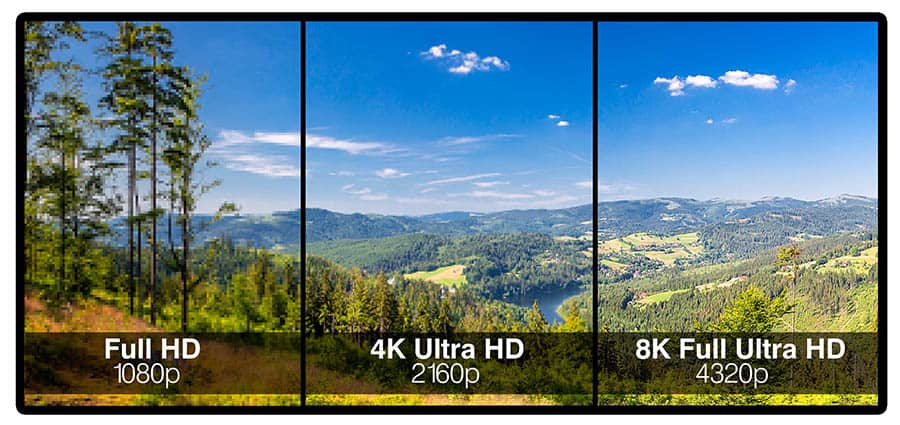If you’re looking to invest in a new projector or television, then you’ve probably come across these different abbreviations that are used to describe the size of the display. But many people aren’t aware of what these different terms mean, and how they’re different to one another
So if you’re looking to understand what exactly SVGA, XGA and WXGA mean, then you’re in the right place. I’m going to break it down for you so it’s very simple to understand, and you’ll have no problems knowing which is right for you.
SVGA vs XGA vs WXGA vs HD vs 4k resolution
Okay, let’s start by mentioning that these are simply all different resolutions of your projector, television or another type of display that you’re watching. Typically, nowadays this is probably going to refer to a projector resolution, as televisions tend to be HD or above.
Your resolution is, quite simply, the amount of pixels that are being shown on your screen. The pixels, which are tiny square blocks on your display, will have an effect on the detail of your image.
And when you increase the number of pixels that you have, you’re going to get a higher resolution. With an increased resolution comes a more detailed picture, which is important if you want the best viewing experience possible.
As technology gets better, the higher the resolution capabilities of our devices come. Nowadays, 1080p (full HD resolution) is pretty much what is considered the standard for many smaller screens. For larger displays, a full 4k resolution is becoming more the norm.
Whilst we’re all talking about 4k in the modern day, it hasn’t always been that way. Before 4k came different measurements, with the earliest being SVGA.
SVGA (Super Video Graphics Array)

Resolution: 800×600 | Total Pixels: 480,000 | Aspect Ratio: 4:3
Of the three measurements, SVGA is the oldest and was the most commonly used for a long time. It refers to a screen that has a resolution of 600p, or 800×600. If we work out the ratio of 800 to 600, then this gives us an aspect ratio of 4:3.
It’s actually just a super version of a VGA port, and actually, it’s not even an official specification. IBM released VGA (640×480p) in the 80s, and by the end of the decade, SVGA was the term used for enhanced graphics cards that could support 600p.
As you can probably tell, by comparison to modern televisions and projections, this is a little lower in resolution and quality than what you may be used to now. However, there’s no denying that it still displays a reasonable enough image for most people.
XGA (Extended Graphics Array)
Resolution:1024×768 | Total Pixels: 786,000 | Aspect Ratio: 4:3
Whilst SVGA was once the most used resolution, the further that our technology has developed, the better more pixels we can use in our displays. An example of this is XGA, or extended graphics array.
This uses the same aspect ratio as an SVGA device, but it has an increased resolution to 768p. This gives the display a lot more pixels overall, and will result in a better quality image. Originally introduced at the start of the 90s, eventually it developed into the 720p (HD ready) resolution we still use today.
You might not be able to notice the difference from a distance on a small screen. But on a larger screen, or if you’re relatively close to it, then you’re definitely going to be able to see the difference.
WXGA resolution (Wide Extended Graphics Array)
Resolution: 1280×800 | Total Pixels: 1,024,000 | Aspect Ratio: 16:10
The name kind of gives this one away, but a WXGA display is slightly different to the two already mentioned. Whilst both SVGA and XGA are at a 4:3 aspect ratio, WXGA is at a 16:10 aspect ratio.
Whilst a 4:3 ratio is what we call the classic TV design, a 16:10 screen is going to be much more widescreen than this. So if you’re looking for a widescreen monitor, then there’s a good chance that it might be 16:10.
With this increase in width comes an increase in pixels too, with this design being 800p, and more than a million pixels overall.
Full HD (High Definition)
Resolution: 1920×1080 | Total Pixels: 2,073,600 | Aspect Ratio: 16:9
High definition is another widescreen display like WXGA, but it is an even higher quality. You’ll often see it referred to as 1080p, and it’s one of the most commonly found resolutions across all devices nowadays.
However, one of the differences between HD and WXGA is actually the aspect ratio too, with HD being an even more widescreen 16:9 ratio.
This is a massive increase in terms of pixels, and it has overall more than twice the amount as WXGA – more than 2 million.
Cinema 4K

Resolution: 4096×2160 | Total Pixels: 8,847,360 | Aspect Ratio: 16:9
At the moment, the maximum resolution that we go to with projectors is up to 4K. But, Cinema 4k is actually higher in resolution than standard 4K.
At this resolution, there is more than 4096 × 2160 pixels on your display, so you can imagine just how detailed your display will be. You’ll be able to notice a slight difference between 4K and HD, but an even greater distance between 4K and WXGA.
There’s more than 8 million pixels in a true 4K resolution, but these models can end up costing quite a bit. So, if you want to watch in the best resolution possible, there’s usually a high price tag.
Aspect Ratio
As well as the resolution, we should also talk about aspect ratios. This is literally just the width by height of the pixels on your display. So if you have a 4:3 aspect ratio, this is 4 pixels wide for every 3 pixels in height. It’s pretty simple once you get the hang of it.

16:9 and 4:3 were the most common aspect ratios until a little over 10 years ago. At this time, 800×600 was one of the most used resolutions amongst computer monitors (800×600 is simply 4:3).
In 2008, we started using the 16:9 resolution much more in both laptops and computer, but also televisions too. 1920×1080, or HD, is probably the best example of a 16:9 aspect ratio resolution.
One of the most important things to think about when considering the resolution of your display is its aspect ratio. This is going to affect the way that you watch things, and your overall view of any screen.
This isn’t limited to just TVs and projectors. Devices like laptops and phones are also designed to the same aspect ratio standard, too.
Conclusion
These are just the differences in resolution between the best we have to offer, and the best we had to offer more than a decade ago. Whilst a standard of 768 pixels is changing into a standard of 1080p, who knows how long it will be before a 4K resolution becomes the new standard.
In fact, the truth is that 4K is probably what most people look for when it comes to a good picture quality. The majority of TVs 40 inches or larger are 4K, with the increased number of pixels being a major selling point for most brands. So, many of these smaller resolutions are now a thing of the past.